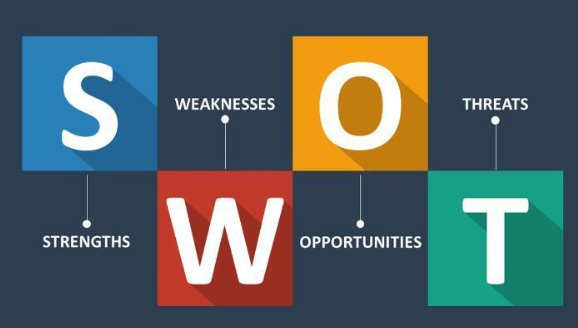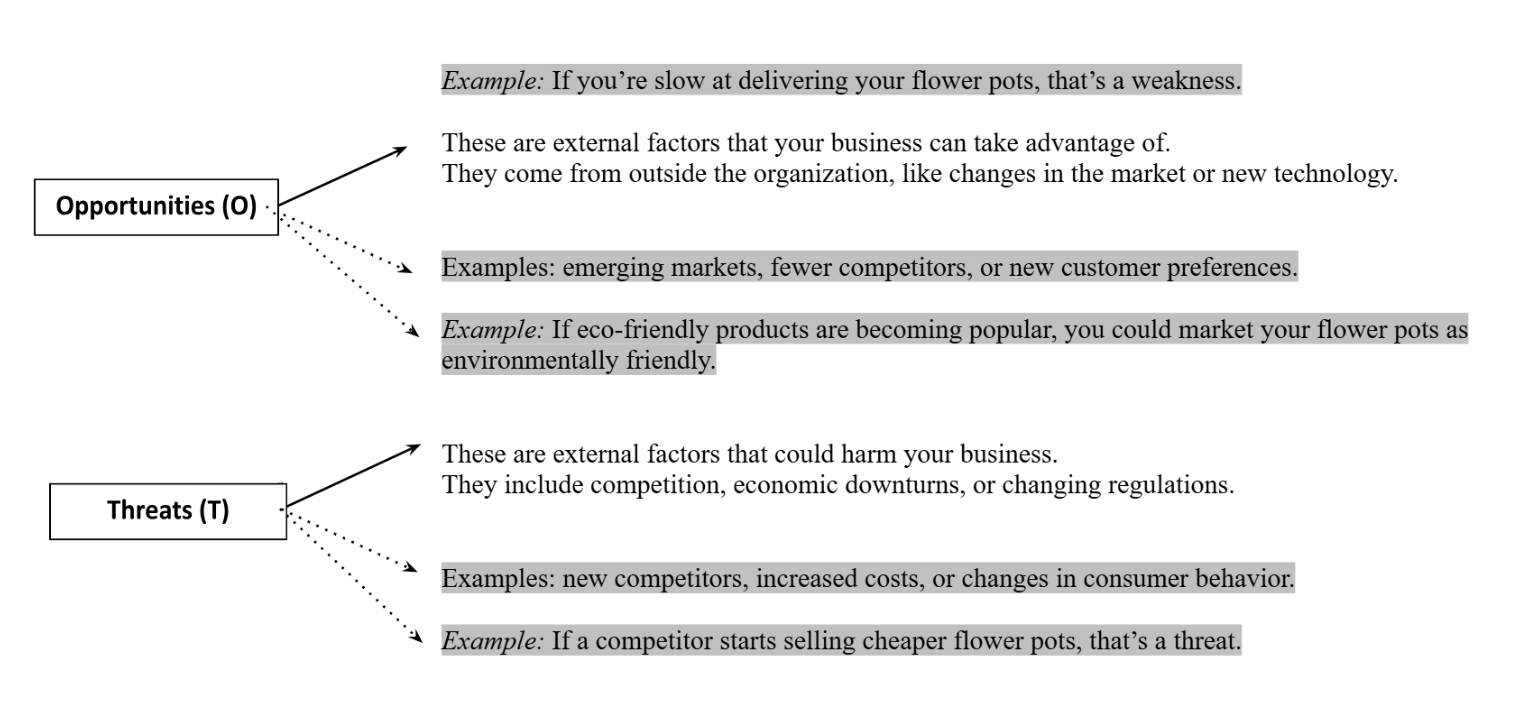WGU D077 OA Study Guide II - 2025 | SWOT Analysis and the BCG Matrix📖
Welcome to the world of business strategy where I will disentangle abracadabra terms and give you actual, tangible tools you can apply. Do you know what SWOT Analysis means or perhaps you’ve come across the BCG Matrix before? If you haven’t, there is no need to freak out – you’re not the only person out here who hasn’t figured it out yet. These are not secret codes to unveil hidden treasures, although they are to certain businesses, in a way. Rather, they are essential tools for corporations to assess themselves, their niches, and rivals on the market.
- SWOT Analysis: A framework for evaluating a company’s Strengths, Weaknesses, Opportunities, and Threats, SWOT analysis helps organizations identify internal and external factors that influence success.
- BCG Matrix: The Boston Consulting Group (BCG) Matrix categorizes business units or products into Stars, Cash Cows, Question Marks, and Dogs based on market growth and market share, aiding in resource allocation and strategic planning.
Ready to dive in? Let’s start with these concepts and try to explain them as clearly as possible. Such critics who said that strategy can’t be interesting? To begin with, we’re going to discuss SWOT Analysis, which is a really useful strategy that helps a business note its Strengths, Weaknesses, Opportunities, and Threats. That is the last self-reflective check-up for the companies, let me assure you, it is a game changer In this strategic marketing course WGU D077 Concepts in Marketing Sales and Customer Contact, you will learn about the BCG Matrix. In this article, I will outline the BCG Matrix in detail and lay it out so that anyone reading this article can grasp and apply the above-stated techniques skillfully.
How to Use This Guide for the WGU D077 OA Exam? 📖
The D077 Concepts in Marketing, Sales, and Customer Contact OA exam at WGU evaluates your understanding of strategic marketing analysis, business growth strategies, and customer relationship management. This guide simplifies the key concepts of SWOT analysis and the BCG matrix to help you grasp the topics tested in the exam.
We also provide exam-style questions and practical applications to ensure you’re fully prepared for the questions on the WGU D077 OA exam.

Understanding SWOT Analysis: A Step-by-Step Guide for Beginners For D077 OA📝
In your WGU D077 module on Concepts in Marketing, Sales, and Customer Contact, you may come across a tool called SWOT Analysis. It’s a valuable and widely used method in strategic planning, and in this article, we’ll break it down into simple steps to help you understand it thoroughly. By the end of this explanation, you’ll not only know what SWOT Analysis is but also how to use it effectively.
What is SWOT Analysis?

SWOT stands for Strengths, Weaknesses, Opportunities, and Threats is a method to identify the internal and external circumstances when planning a venture. In some ways it is like applying a lens or a set of glasses, that lets you see what you’re great at, where there is room for growth, what opportunities exist for you, and what risks exist in the business world.
Think of it like this: if you wish to achieve some goal don’t you deserve to know the key performers (strengths), areas of weakness (weaknesses), points of ease (opportunities), and tricks of the rivals (threats)? At the core of all of these, this is the function that SWOT Analysis performs, just for business and projects, though.
Why is SWOT Analysis Important?
SWOT Analysis helps organizations:
- Understand Themselves: It highlights what they do well and where they can improve.
- Plan Strategically: By knowing their strengths and weaknesses, they can make better decisions.
- Prepare for the Future: By recognizing opportunities and threats, they can stay ahead in their market.
For example, if a company finds out it has a strong online presence (strength) but lacks physical stores (weakness), it can focus on online sales (opportunity) while planning to open a few physical outlets to tackle potential competitors (threat).
The Four Components of SWOT Analysis
Let’s take a closer look at the four key areas of SWOT Analysis:


How to Conduct a SWOT Analysis
Here’s a simple guide to conducting your SWOT Analysis:

SWOT Analysis isn’t just for big companies. It can be used in:
- Marketing: To craft campaigns that highlight strengths and address weaknesses.
- Sales: To identify unique selling points and target specific customer needs.
- Strategic Planning: To prepare for future challenges and opportunities.
Example: SWOT Analysis for a Small Flower Pot Business
Let’s imagine you own a flower pot business. Here’s what your SWOT Analysis might look like:
Strengths | Weaknesses |
High-quality pots | Limited marketing budget |
Loyal customers | Small production capacity |
Opportunities | Threats |
Growing demand for eco-friendly products | Competitors with lower prices |
Online sales growth | Rising material costs |
By looking at this analysis, you might decide to focus on promoting your eco-friendly pots online to leverage opportunities while finding ways to reduce material costs to address threats. Additionally, encouraging loyal customers to share positive reviews online could boost your reputation and drive new sales. Scaling production gradually could meet growing demand without overwhelming resources, and offering unique designs or eco-friendly packaging might help you stand out from competitors.
Regularly monitoring what competitors are doing and adjusting your strategies would ensure your business remains competitive, providing a solid framework for long-term growth and resilience.
By taking these steps, your business can capitalize on its strengths and opportunities while effectively addressing weaknesses and threats.
Tips for Mastering SWOT Analysis For D077 OA
Here are some quick tips to help you succeed:
- Be Honest: A good SWOT Analysis requires recognizing your true strengths and weaknesses.
- Stay Focused: Don’t try to list everything—focus on the most impactful factors.
- Use Real Data: Whenever possible, base your analysis on real numbers and facts.
- Keep it Updated: Markets change, so make sure to revisit and update your SWOT Analysis regularly.
Why is SWOT Analysis Relevant to WGU D077?
In your WGU D077 studies, understanding tools like SWOT Analysis will prepare you for real-world challenges in marketing, sales, and customer contact. It’s a key concept that might appear in WGU D077 OA questions, so take time to master it. By practicing with case studies and examples, you can connect theory to practice.
Conclusion
SWOT Analysis is a simple yet powerful tool that helps businesses understand their strengths, weaknesses, opportunities, and threats. By learning how to conduct one effectively, you’ll be better equipped to make strategic decisions. Whether it’s for your studies at WGU D077 or real-life applications, this knowledge will give you an edge in analyzing business situations. Remember to review supplemental materials and try out practical examples to solidify your understanding. Good luck!
Now let us move onto the second topic of today,
Understanding the BCG Matrix: A Strategic Tool for Business Growth For D077 OA📝
In the WGU D077 module on Concepts in Marketing, Sales, and Customer Contact, you’ll encounter the BCG Matrix—a powerful tool for strategic planning. This article will explain the BCG Matrix step-by-step in a simple, conversational way, so you can master its concepts and apply them effectively.
What is the BCG Matrix?

The BCG Matrix or the Boston Consulting Group Growth-Share Matrix is a strategic planning tool, used to evaluate the businesses’ product portfolio. It provides a visual framework to categorize products or business units into four distinct groups based on two critical factors:
- Market Share: This measures the product’s dominance in its market compared to competitors. A higher market share indicates a stronger competitive position.
- Market Growth Rate: This represents how fast the overall market for a product is expanding. A high growth rate suggests more opportunities for revenue generation.
Originally implemented by the Boston Consulting Group in the 1970s ′s, the matrix helps in determining the most effective resource deployment by a firm with regard to its products. When knowing which products need investment, which should be kept going, and which should be dumped, businesses can then achieve maximum profitability and sustainable growth.
The BCG Matrix is best because of its purpose of providing a clear due north for portfolio management decisions which would otherwise be tremendously complicated. That is a dynamic tool, which should be updated timely depending on some changes in the market conditions and business strategies.
The Four Quadrants of the BCG Matrix
Each quadrant of the matrix has unique characteristics and strategic recommendations:
Quadrant | Characteristics | Strategy | Example |
Stars | Products with high market share in high-growth markets. | Invest heavily in Stars to maintain or increase their market share. These are future Cash Cows. | A tech company’s newest smartphone model dominates the market while smartphone demand grows. |
Cash Cows | Products with high market share in low-growth markets. | Optimize and maintain these products to maximize profitability. | A company’s line of household cleaning products that consistently sell well in a stable market. |
Question Marks | Products with low market share in high-growth markets. | Evaluate carefully. Invest selectively in those with the potential to become Stars, or divest them. | A start-up’s innovative but underperforming app in a booming app market. |
Dogs | Products with low market share in low-growth markets. | Consider discontinuing or repositioning these products as they typically drain resources. | An outdated product line in a declining industry. |
Each of these quadrants offers essential insights into how businesses can manage their product portfolios. Stars represent high-growth opportunities that require significant investment to secure future profitability. Cash Cows act as steady revenue generators, providing the financial backbone for other ventures. Question Marks are areas of potential, demanding careful evaluation to determine whether they warrant further investment. Dogs, while often resource-draining, might occasionally serve niche purposes or require discontinuation to free up resources. Together, these quadrants allow businesses to strategically allocate resources, balancing immediate needs with long-term growth objectives.
How to Conduct a BCG Matrix Analysis
To create a BCG Matrix for your business, follow these steps:

Strategic Implications of the BCG Matrix
The BCG Matrix provides a roadmap for effective resource allocation and long-term planning. Each quadrant offers unique strategic insights:
- Stars, businesses should focus on scaling production, increasing market penetration, and innovating to sustain their dominant position in high-growth markets. Stars are pivotal for future profitability as they often become Cash Cows when market growth stabilizes. Investing heavily in Stars ensures the company maintains its competitive edge.
- Cash Cows are the financial backbone of a business. They require minimal investment while delivering consistent returns. Companies can use the surplus cash generated by Cash Cows to fund the development of Stars and promising Question Marks. The strategy here involves cost optimization and maintaining customer loyalty to maximize their profitability.
- Question Marks present both risk and opportunity. These products operate in high-growth markets but lack a strong market share. Companies need to carefully analyze their potential. Strategic actions may include targeted marketing campaigns, research, and pilot projects to determine whether these products can be transformed into Stars. If they fail to show promise, divesting or reallocating resources becomes necessary.
- Dogs often represent products that are no longer viable in a portfolio due to low market share and minimal growth prospects. While they may occasionally serve niche markets, the typical strategy involves either repositioning or phasing them out. This frees up resources that can be redirected towards more profitable areas, ensuring the company’s portfolio remains focused and competitive.
Overall, the BCG Matrix ensures that businesses allocate resources efficiently, prioritizing products that align with their growth objectives while minimizing waste on unproductive ventures.
Practical Applications of the BCG Matrix
The BCG Matrix isn’t limited to physical products. It can also be applied to:
Digital Marketing: Categorize digital assets such as social media platforms, email campaigns, and paid advertisements. For example:
- Stars: Emerging platforms with high engagement.
- Cash Cows: Established campaigns with steady returns.
- Question Marks: Experimental channels with potential.
- Dogs: Underperforming ads or outdated strategies.
Case Studies: Analyze real-world scenarios where companies used the BCG Matrix to make strategic decisions. This helps visualize the matrix’s impact.
Interactive Exercises: Create your own BCG Matrix for a hypothetical or real product portfolio to practice resource allocation.
Example: Applying the BCG Matrix to a Beverage Company
Imagine a beverage company with a variety of products:
- Stars: Their flagship energy drink, which dominates a rapidly growing energy drink market.
- Cash Cows: A line of sodas with consistent sales but limited market growth.
- Question Marks: A new line of health drinks that hasn’t yet gained traction in the competitive wellness market.
- Dogs: A declining line of bottled teas that no longer resonates with consumers.
Using the BCG Matrix, the company might decide to:
- Invest in marketing and production for the energy drink.
- Optimize operations for the soda line to maintain profitability.
- Experiment with targeted campaigns for health drinks to boost market share.
- Phase out the bottled tea line and redirect resources elsewhere.
Tips for Mastering the BCG Matrix For D077 OA
Here are a few key tips to help you make the most of the BCG Matrix:
- Use Real Data: Base your analysis on reliable market research and sales figures.
- Be Flexible: The matrix is a snapshot in time; markets and products evolve.
- Reassess Regularly: Update your BCG Matrix periodically to adapt to market changes.
- Prioritize Resources: Use the matrix to allocate funds and effort where they’ll have the most impact.
Why is the BCG Matrix Relevant to WGU D077?
The BCG Matrix provides a structured way to analyze product performance and make strategic decisions—key skills for your WGU D077 module. Understanding this tool will prepare you for real-world challenges in marketing and business strategy. Plus, it’s a concept you might encounter in WGU D077 OA questions, so mastering it can help you succeed academically and professionally.
Conclusion
The BCG Matrix is an invaluable tool for analyzing products and making informed strategic decisions. By learning to apply it effectively, you’ll gain insights into resource allocation and business growth strategies. Whether it’s for your studies at WGU D077 or practical applications, understanding the BCG Matrix will give you a competitive edge. Start practicing today, and you’ll be well-prepared for both academic and business success!
Tired of reading blog articles?
Let’s Watch Our Free WGU D077 Practice Questions Video Below!

Wrapping Up Your Strategic Toolkit for WGU D077 OA📖
As you journey through the WGU D077 module, mastering tools like SWOT Analysis and the BCG Matrix will be essential for your success. These concepts are more than just theoretical—they provide actionable insights that can drive real-world business strategies. From understanding your strengths and weaknesses to categorizing your products for optimal resource allocation, these frameworks will help you think strategically and act decisively.
Remember, these topics aren’t just for fun (though we tried to make them interesting!); they’re also critical components of your WGU D077 OA. So, take the time to truly grasp these ideas, practice with examples, and relate them to real-world scenarios. You’ve got this! Good luck with your studies and your final OA. Go show the business world what you’re made of!






